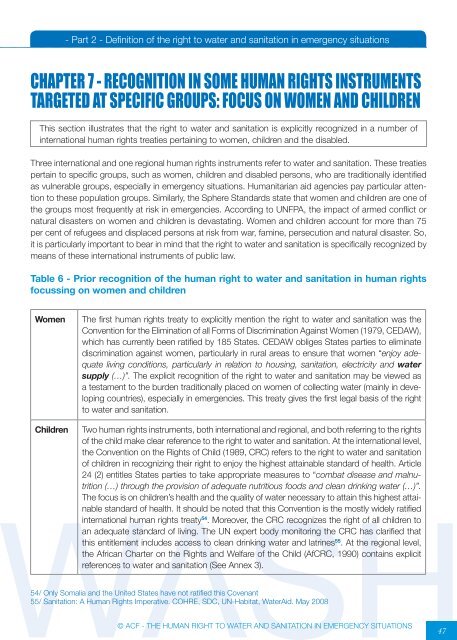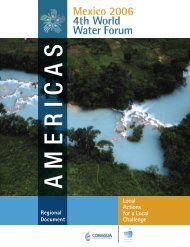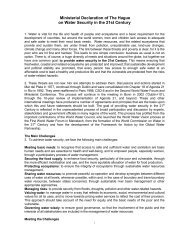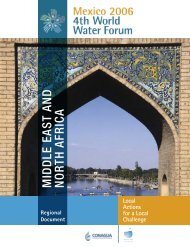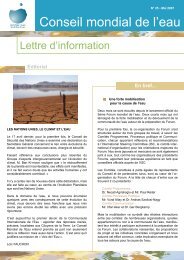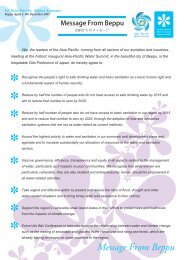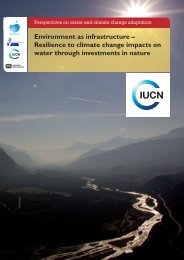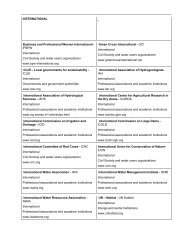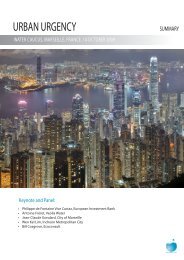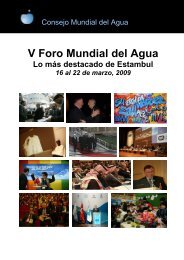the human right to water and sanitation in emergency situations
the human right to water and sanitation in emergency situations
the human right to water and sanitation in emergency situations
Create successful ePaper yourself
Turn your PDF publications into a flip-book with our unique Google optimized e-Paper software.
- Part 2 - Def<strong>in</strong>ition of <strong>the</strong> <strong>right</strong> <strong>to</strong> <strong>water</strong> <strong>and</strong> <strong>sanitation</strong> <strong>in</strong> <strong>emergency</strong> <strong>situations</strong><br />
CHApTER 7 - RECOGNITION IN SOME HUMAN RIGHTS INSTRUMENTS<br />
TARGETED AT SpECIfIC GROUpS: fOCUS ON WOMEN AND CHIlDREN<br />
This section illustrates that <strong>the</strong> <strong>right</strong> <strong>to</strong> <strong>water</strong> <strong>and</strong> <strong>sanitation</strong> is explicitly recognized <strong>in</strong> a number of<br />
<strong>in</strong>ternational <strong>human</strong> <strong>right</strong>s treaties perta<strong>in</strong><strong>in</strong>g <strong>to</strong> women, children <strong>and</strong> <strong>the</strong> disabled.<br />
Three <strong>in</strong>ternational <strong>and</strong> one regional <strong>human</strong> <strong>right</strong>s <strong>in</strong>struments refer <strong>to</strong> <strong>water</strong> <strong>and</strong> <strong>sanitation</strong>. These treaties<br />
perta<strong>in</strong> <strong>to</strong> specific groups, such as women, children <strong>and</strong> disabled persons, who are traditionally identified<br />
as vulnerable groups, especially <strong>in</strong> <strong>emergency</strong> <strong>situations</strong>. Humanitarian aid agencies pay particular attention<br />
<strong>to</strong> <strong>the</strong>se population groups. Similarly, <strong>the</strong> Sphere St<strong>and</strong>ards state that women <strong>and</strong> children are one of<br />
<strong>the</strong> groups most frequently at risk <strong>in</strong> emergencies. Accord<strong>in</strong>g <strong>to</strong> UNFPA, <strong>the</strong> impact of armed conflict or<br />
natural disasters on women <strong>and</strong> children is devastat<strong>in</strong>g. Women <strong>and</strong> children account for more than 75<br />
per cent of refugees <strong>and</strong> displaced persons at risk from war, fam<strong>in</strong>e, persecution <strong>and</strong> natural disaster. So,<br />
it is particularly important <strong>to</strong> bear <strong>in</strong> m<strong>in</strong>d that <strong>the</strong> <strong>right</strong> <strong>to</strong> <strong>water</strong> <strong>and</strong> <strong>sanitation</strong> is specifically recognized by<br />
means of <strong>the</strong>se <strong>in</strong>ternational <strong>in</strong>struments of public law.<br />
Table 6 - Prior recognition of <strong>the</strong> <strong>human</strong> <strong>right</strong> <strong>to</strong> <strong>water</strong> <strong>and</strong> <strong>sanitation</strong> <strong>in</strong> <strong>human</strong> <strong>right</strong>s<br />
focuss<strong>in</strong>g on women <strong>and</strong> children<br />
Women The first <strong>human</strong> <strong>right</strong>s treaty <strong>to</strong> explicitly mention <strong>the</strong> <strong>right</strong> <strong>to</strong> <strong>water</strong> <strong>and</strong> <strong>sanitation</strong> was <strong>the</strong><br />
Convention for <strong>the</strong> Elim<strong>in</strong>ation of all Forms of Discrim<strong>in</strong>ation Aga<strong>in</strong>st Women (1979, CEDAW),<br />
which has currently been ratified by 185 States. CEDAW obliges States parties <strong>to</strong> elim<strong>in</strong>ate<br />
discrim<strong>in</strong>ation aga<strong>in</strong>st women, particularly <strong>in</strong> rural areas <strong>to</strong> ensure that women “enjoy adequate<br />
liv<strong>in</strong>g conditions, particularly <strong>in</strong> relation <strong>to</strong> hous<strong>in</strong>g, <strong>sanitation</strong>, electricity <strong>and</strong> <strong>water</strong><br />
supply (…)”. The explicit recognition of <strong>the</strong> <strong>right</strong> <strong>to</strong> <strong>water</strong> <strong>and</strong> <strong>sanitation</strong> may be viewed as<br />
a testament <strong>to</strong> <strong>the</strong> burden traditionally placed on women of collect<strong>in</strong>g <strong>water</strong> (ma<strong>in</strong>ly <strong>in</strong> develop<strong>in</strong>g<br />
countries), especially <strong>in</strong> emergencies. This treaty gives <strong>the</strong> first legal basis of <strong>the</strong> <strong>right</strong><br />
<strong>to</strong> <strong>water</strong> <strong>and</strong> <strong>sanitation</strong>.<br />
Children Two <strong>human</strong> <strong>right</strong>s <strong>in</strong>struments, both <strong>in</strong>ternational <strong>and</strong> regional, <strong>and</strong> both referr<strong>in</strong>g <strong>to</strong> <strong>the</strong> <strong>right</strong>s<br />
of <strong>the</strong> child make clear reference <strong>to</strong> <strong>the</strong> <strong>right</strong> <strong>to</strong> <strong>water</strong> <strong>and</strong> <strong>sanitation</strong>. At <strong>the</strong> <strong>in</strong>ternational level,<br />
<strong>the</strong> Convention on <strong>the</strong> Rights of Child (1989, CRC) refers <strong>to</strong> <strong>the</strong> <strong>right</strong> <strong>to</strong> <strong>water</strong> <strong>and</strong> <strong>sanitation</strong><br />
of children <strong>in</strong> recogniz<strong>in</strong>g <strong>the</strong>ir <strong>right</strong> <strong>to</strong> enjoy <strong>the</strong> highest atta<strong>in</strong>able st<strong>and</strong>ard of health. Article<br />
24 (2) entitles States parties <strong>to</strong> take appropriate measures <strong>to</strong> “combat disease <strong>and</strong> malnutrition<br />
(…) through <strong>the</strong> provision of adequate nutritious foods <strong>and</strong> clean dr<strong>in</strong>k<strong>in</strong>g <strong>water</strong> (…)”.<br />
The focus is on children’s health <strong>and</strong> <strong>the</strong> quality of <strong>water</strong> necessary <strong>to</strong> atta<strong>in</strong> this highest atta<strong>in</strong>able<br />
st<strong>and</strong>ard of health. It should be noted that this Convention is <strong>the</strong> mostly widely ratified<br />
<strong>in</strong>ternational <strong>human</strong> <strong>right</strong>s treaty 54 . Moreover, <strong>the</strong> CRC recognizes <strong>the</strong> <strong>right</strong> of all children <strong>to</strong><br />
an adequate st<strong>and</strong>ard of liv<strong>in</strong>g. The UN expert body moni<strong>to</strong>r<strong>in</strong>g <strong>the</strong> CRC has clarified that<br />
this entitlement <strong>in</strong>cludes access <strong>to</strong> clean dr<strong>in</strong>k<strong>in</strong>g <strong>water</strong> <strong>and</strong> latr<strong>in</strong>es 55 . At <strong>the</strong> regional level,<br />
<strong>the</strong> African Charter on <strong>the</strong> Rights <strong>and</strong> Welfare of <strong>the</strong> Child (AfCRC, 1990) conta<strong>in</strong>s explicit<br />
references <strong>to</strong> <strong>water</strong> <strong>and</strong> <strong>sanitation</strong> (See Annex 3).<br />
54/ Only Somalia <strong>and</strong> <strong>the</strong> United States have not ratified this Covenant<br />
55/ Sanitation: A Human Rights Imperative. COHRE, SDC, UN-Habitat, WaterAid. May 2008<br />
© ACF - THE HUMAN RIGHT TO WATER AND SANITATION IN EMERGENCY SITUATIONS<br />
47


